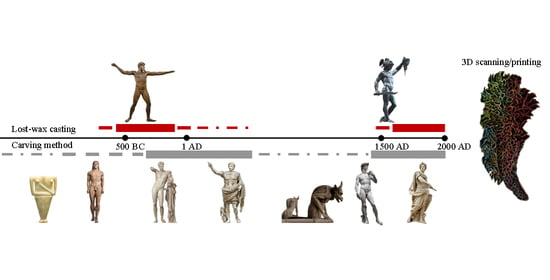3D Scanning/Printing: A Technological Stride in Sculpture
Abstract
:1. Introduction
2. The Three Historical Steps in Sculpture Techniques
- Knowledge of the prototype;
- Profound conception of the representation;
- Evaluation of the representation.
2.1. Carving Method
2.2. Lost-Wax Casting Method
2.3. The Benefits of Lost-Wax Casting
2.4. 3D Scanning and 3D Printing
The early roots of 3D printing lie in photo-sculpture and topography [41]. In 1860, French artist François Willème patented a photo-sculpturing method. In this process, the subject is placed in a circular room and photographed simultaneously by 24 cameras equally spaced around the room. Willème then traced the 24 profiles using a cutter attached to a pantograph. Tracing the profile’s shape would simultaneously cut the wood. He assembled these layers of wood to create a photo-sculpture.
It is like a composer sitting down with notes and chords to get a feel for where the music is going.
Consider the digital process as just another tool that you are trying to master
- Photogrammetry is a method by which we can create 3D models using many photographs of an object from different angles [60]. The first steps of photogrammetry were made in the field of surveying for the purpose of modeling geographical terrain [61]. The only instruments needed are a camera and appropriate software. The increasing demand for modeling and digitizing the real world in recent years has led to the radical development of the applications of photogrammetry [62,63,64,65].
- Computerized tomography (CT) is a method where a series of 2D X-rays photographs is taken in different sections. Even though this method has been used in the 3D modeling of sculptures for high-value artifacts [75,76], it is very expensive and complex. Most applications of CT scanning are in medicine [77].
The rise of 3D printing technology makes sculpture completely bid farewell to the manual era and enter the era of digital design and manufacturing. Sculptors design sculpture models by relying on computers, which is conducive to promoting the development and innovation of sculpture art. 3D printing technology can display the pictures depicted in the hearts of artists and sculptors in the form of real objects completely, which can maximize the artistic expression.
- SLA: A laser ray is guided point to point, hitting a polymeric liquid. When the laser hits the liquid, a chemical process is triggered, which solidifies the liquid [92].
- SLS: A leveling roller spreads a thin layer of powdered material across a powder bed. A CO2 laser traces the cross-section of the material, and as the laser scans the surface, the material is heated and fused together [93].
- DLP: A light projector is used to project the image of an entire layer simultaneously on a polymeric liquid. The layer is created when light hits the liquid [97].
- MJF: An inkjet array is used to selectively apply pixel-like elements of a synthetic material. After its application, material is fused into a solid layer of a specific geometry [98].
- PJ: A print head is used to deposit small pieces of ultraviolet curable material, eventually forming a single cross-section. An ultraviolet light attached to the print head simultaneously cures the material as it is printed [99].
- WAAM: A robotic arm with an electric arc welding process is used to melt a metal wire. Guided by the 3D digital model, the robotic arm accurately deposits the melted metal in layers [104,105]. This method is considered to be very promising with a wide range of printing capabilities (large-scale projects) [106].
2.5. 3D Scanning/Printing as a Stride for Civilization
3. Material Poetics in 3D Scanning/Printing
4. The Role of 3D Scanning/Printing in the Preservation of Culture
5. Conclusions
Author Contributions
Funding
Institutional Review Board Statement
Informed Consent Statement
Data Availability Statement
Acknowledgments
Conflicts of Interest
References
- Koutsoyiannis, D.; Sargentis, G.-F. Entropy and Wealth. Entropy 2021, 23, 1356. [Google Scholar] [CrossRef] [PubMed]
- Sargentis, G.-F.; Iliopoulou, T.; Dimitriadis, P.; Mamassis, N.; Koutsoyiannis, D. Stratification: An Entropic View of Society’s Structure. World 2021, 2, 153–174. [Google Scholar] [CrossRef]
- Wittfogel, K. Oriental Despotism; A Comparative Study of Total Power; Random House: New York, NY, USA, 1957; ISBN 978-0-394-74701-9. [Google Scholar]
- Rudofsky, B. Architecture Without Architects: A Short Introduction to Non-Pedigreed Architecture; UNM Press: Albuquerque, NM, USA, 1987; Available online: https://books.google.gr/books?hl=en&lr=&id=F_khGKj2sKwC&oi=fnd&pg=PA24&dq=architecture+as+a+footprint+of+civilization&ots=tFO4jPT21P&sig=mDK0sww91NNQSn0nE-yapktM0Tk&redir_esc=y#v=onepage&q&f=false (accessed on 15 December 2021).
- Tunis, E. Wheels. A Pictorial History; The Johns Hopkins University Press: Baltimore, MD, USA; London, UK, 2002; Available online: https://books.google.gr/books?hl=en&lr=&id=oBn92dOgx3AC&oi=fnd&pg=PA45&dq=Wheels:+A+Pictorial+History&ots=wxMIsMi3ue&sig=lb6KoeiIZZkUh9w0I6bqJYgNZ58&redir_esc=y#v=onepage&q=Wheels%3A%20A%20Pictorial%20History&f=false (accessed on 28 August 2021).
- Angelakis, A. Evolution of rainwater harvesting and use in Crete, Hellas, through the millennia. Water Sci. Technol. Water Supply 2016, 16, 1624–1638. [Google Scholar] [CrossRef]
- Koutsoyiannis, D.; Zarkadoulas, N.; Angelakis, A.N.; Tchobanoglous, G. Urban Water management in Ancient Greece: Legacies and Lessons. ASCE J. Water Resour. Plan. Manag. 2008, 134, 45–54. [Google Scholar] [CrossRef] [Green Version]
- Dewan, R. Bronze Age Flower Power: The Minoan Use and Social Significance of Saffron and Crocus Flowers, Institute for European and Mediterranean Archaeology. Chronica 2015, 5, 42–55. Available online: http://www.chronikajournal.com/resources/Dewan%202015.pdf (accessed on 25 August 2021).
- Freeth, T.; Bitsakis, Y.; Moussas, X.; Seiradakis, J.H.; Tselikas, A.; Mangou, H.; Zafeiropoulou, M.; Hadland, R.; Bate, D.; Ramsey, A.; et al. Decoding the ancient Greek astronomical calculator known as the Antikythera Mechanism. Nature 2006, 444, 587–591. [Google Scholar] [CrossRef]
- Nietzsche’s Last Notebooks 1888, Ferrer, D.F., Translator. Available online: https://philpapers.org/archive/FERNLN.pdf (accessed on 25 August 2021).
- Pollitt, J.J. The Art of Ancient Greece: Sources and Documents; Cambridge University Press: Cambridge, UK, 1990. [Google Scholar]
- Hasaki, E. Craft Apprenticeship in Ancient Greece: Reaching beyond the Masters. In Archaeology and Apperenticeship, Body Knowledge, Identity and Communities of Practice; Wendrich, W., Ed.; The University of Arizona Press: Tucson, AZ, USA, 2012. [Google Scholar]
- Brion, M. Michalangelo (Μιχαήλ-Άγγελος); Ioannidis, P.S., Translator; Phos: Athens, Greece, 1970. [Google Scholar]
- Shahrubudin, N.; Lee, T.C.; Ramlan, R. An Overview on 3D Printing Technology: Technological, Materials, and Applications, Procedia Manufacturing; Elsevier: Amsterdam, The Netherlands, 2019; Volume 35, pp. 1286–1296, ISSN 2351-9789. [Google Scholar] [CrossRef]
- Petersen, E.E.; Kidd, R.W.; Pearce, J.M. Impact of DIY Home Manufacturing with 3D Printing on the Toy and Game Market. Technologies 2017, 5, 45. [Google Scholar] [CrossRef]
- Mount Rushmore. Available online: https://en.wikipedia.org/wiki/Mount_Rushmore (accessed on 28 August 2021).
- The Motherland Calls. Available online: https://en.wikipedia.org/wiki/The_Motherland_Calls (accessed on 28 August 2021).
- Statue of Unity. Available online: https://en.wikipedia.org/wiki/Statue_of_Unity (accessed on 28 August 2021).
- Ramesses, II. Available online: https://en.wikipedia.org/wiki/Ramesses_II (accessed on 28 August 2021).
- Statue of Liberty. Available online: https://en.wikipedia.org/wiki/Statue_of_Liberty (accessed on 28 August 2021).
- Mattusch, C. The Berlin Foundry Cup: The Casting of Greek Bronze Statuary in the Early Fifth Century B. C. Am. J. Archaeol. 1980, 84, 435–444. [Google Scholar] [CrossRef]
- Koroneos, A.; Sargentis, G.-F. Casting of the Bust of Professor A. Prokopiou, Research Report, Laboratory of Building Materials; National Technical University of Athens: Athens, Greece, 2005. [Google Scholar] [CrossRef]
- Pausanias, Description of Greece, Arkadika, Book 8 (Παυσανίας -Ελλάδος περιήγησις, Aρκαδικά, Βιβλίο 8). Available online: https://kupdf.net/download/-http-wwwprojethomerecom_5af3ab29e2b6f555101910ae_pdf (accessed on 25 August 2021).
- Rodin, A. The Art (H Τέχνη); Syrros, A., Translator; Estia Tou Bibliou: Athens, Greece, 1954. [Google Scholar]
- Sargentis, G.-F. Use and Technical Aspects of Materials in Sculpture. Ph.D. Thesis, School of Architecture, National Technical University of Athens, Athens, Greece, 2005. [Google Scholar] [CrossRef]
- Mattusch, C. Greek Bronze Statuary: From the Beginnings through the Fifth Century BC; Cornell University Press: Ithaca, Greece; London, UK, 1988. [Google Scholar]
- Kouros, Anabyssos. Available online: https://en.wikipedia.org/wiki/Kouros#/media/File:Kouros_anavissos.jpg (accessed on 28 August 2021).
- Poseidon or Zeus of Artemision. Available online: https://el.wikipedia.org/wiki/Ποσειδώνας_του_Aρτεμισίου (accessed on 28 August 2021).
- Claridge, A. Marble Carving. In The Oxford Handbook of Roman Sculputre; Friedland, E.A., Sobocinski, M.G., Elaine, K.G., Eds.; Oxford University Press: New York, NY, USA, 2015. [Google Scholar]
- Mattusch, C. The Casting of Greek Bronzes: Variation and Repetition, In Proceeding of the Symposium of Small Bronze Sculpture from the Ancient World, March 1989 at the Getty Museum; The J. Paul Getty Museum: Los Angeles, CA, USA, 1990; Available online: https://www.getty.edu/publications/resources/virtuallibrary/089236176X.pdf (accessed on 15 December 2021).
- Luchs, A.; May, K.; Sturman, S. Conjecture on the origins and findings on the facture of the budapest horse. In Leonardo Da Vinci & the Budapest Horseand Rider; Kárpáti, Z., Ed.; Museum of Fine Arts: Budapest, Hungary, 2018. [Google Scholar]
- Hunt, L.B. The long history of lost wax casting. Gold Bull 1980, 13, 63–79. [Google Scholar] [CrossRef] [Green Version]
- Motture, P. Introduction. Studies in the History of Art; National Gallery of Art: Washington, DC, USA, 2003; Volume 64, pp. 9–15. Available online: http://www.jstor.org/stable/42622332 (accessed on 15 December 2021).
- Davey, C.J. The Early History of Lost-Wax Casting. In Metallurgy and Civilisation: Eurasia and Beyond; Mei, J., Regren, T., Eds.; Archetype Publications: London, UK, 2009; pp. 147–177. Available online: https://www.academia.edu/4614800/ (accessed on 28 August 2021).
- Pliny the Elder. The Natural History of Pliny; Henry, G.B., Ed.; Bostock, J.; Riley, H.T., Translators; Oxford University Press: London, UK, 1865; Available online: https://books.google.gr/books?hl=en&lr=&id=sDwZAAAAYAAJ&oi=fnd&pg=PA1&dq=pliny+natural+history (accessed on 11 December 2021).
- Ron Mueck. Available online: https://en.wikipedia.org/wiki/Ron_Mueck (accessed on 28 August 2021).
- Scopigno, R.; Cignoni, P.; Pietroni, N.; Callieri, M.; Dellepiane, M. Digital Fabrication Techniques for Cultural Heritage: A Survey. Comput. Graph. Forum 2017, 36, 6–21. [Google Scholar] [CrossRef]
- Powder Bed and Inkjet Head 3D Printing. Available online: https://en.wikipedia.org/wiki/Powder_bed_and_inkjet_head_3D_printing (accessed on 28 August 2021).
- Williams, L.D. Additive Manufacturing or 3d Scanning and Printing. In Manufacturing Engineering Handbook; McGraw-Hill: New York, NY, USA, 2015. [Google Scholar]
- Marquardt, T.; Zheng, E. History of 3D Printing. Available online: https://blogs.lawrence.edu/makerspace/history/#2 (accessed on 11 December 2021).
- Bourella, D.L.; Beaman, J.J.; Leub, M.C.; Rosenc, D.W. History of Additive Manufacturing and the 2009 Roadmap for Additive Manufacturing: Looking Back and Looking Ahead. In Proceedings of the RapidTech 2009: US-TURKEY Workshop on RapidTechnologies, Istanbul, Turkey, 24 September 2009; pp. 1–8. Available online: http://www.turkcadcam.net/haber/2009/rapidtech-workshop/presentations/Presentation02.pdf (accessed on 11 December 2021).
- Edl, M.; Mizerak, M.; Trojan, J. 3D laser scanners: History and applications. Int. Sci. J. About Simul. 2018, 4, 1–5, ISSN 1339-9640. [Google Scholar] [CrossRef]
- Levoy, M.; Pulli, K.; Curless, B.; Rusinkiewicz, S.; Koller, D.; Pereira, L.; Ginzton, M.; Anderson, S.; Davis, J.; Ginsberg, J.; et al. The Digital Michelangelo Project: 3D Scanning of Large Statues; University of Stanford: Stanford, CA, USA, 2000; Available online: http://graphics.stanford.edu/papers/dmich-sig00/ (accessed on 11 November 2021).
- Horvath, J. A Brief History of 3D Printing. In Mastering 3D Printing; Apress: Berkeley, CA, USA, 2014. [Google Scholar] [CrossRef]
- Hughes, B.; Wilson, G. 3D/additive printing manufacturing: A Brief History and Purchasing Guide. Technol. Eng. Teach. 2015, 75, 18. Available online: https://eric.ed.gov/?id=EJ1083038 (accessed on 13 January 2021).
- Scopus Database. Available online: https://www.scopus.com/ (accessed on 15 December 2021).
- Michel, J.B.; Shen, Y.K.; Aiden, A.P.; Veres, A.; Gray, M.K.; Pickett, J.P.; Hoiberg, D.; Clancy, D.; Norvig, P.; Orwant, J.; et al. Quantitative analysis of culture using millions of digitized books. Science 2011, 331, 176–182. [Google Scholar] [CrossRef] [Green Version]
- Google Books Ngram Viewer. Available online: https://books.google.com/ngrams/ (accessed on 15 December 2021).
- Araújo, N.; Pacheco, V.; Costa, L. Smart Additive Manufacturing: The Path to the Digital Value Chain. Technologies 2021, 9, 88. [Google Scholar] [CrossRef]
- Delda, R.N.M.; Basuel, R.B.; Hacla, R.P.; Martinez, D.W.C.; Cabibihan, J.-J.; Dizon, J.R.C. 3D Printing Polymeric Materials for Robots with Embedded Systems. Technologies 2021, 9, 82. [Google Scholar] [CrossRef]
- Dizon, J.R.C.; Gache, C.C.L.; Cascolan, H.M.S.; Cancino, L.T.; Advincula, R.C. Post-Processing of 3D-Printed Polymers. Technologies 2021, 9, 61. [Google Scholar] [CrossRef]
- Mielczarek, J.; Gazdowicz, G.; Kramarz, J.; Łątka, P.; Krzykawski, M.; Miroszewski, A.; Pieczarko, P.; Szczelina, R.; Warchoł, P.; Wróbel, S. A Prototype of a 3D Bioprinter. Solid State Phenom. 2015, 237, 221–226. [Google Scholar] [CrossRef]
- Ishack, S.; Lipner, S.R. Applications of 3D Printing Technology to Address COVID-19-Related Supply Shortages. Am. J. Med. 2020, 133, 771–773. [Google Scholar] [CrossRef]
- Duda, T.L.; Raghavan, V. 3D Metal Printing Technology. IFAC-PapersOnLine 2016, 49, 103–110, ISSN 2405-8963. [Google Scholar] [CrossRef]
- Li, J.; Nie, L.; Li, Z.; Lin, L.; Tang, L.; Ouyang, J. Maximizing modern distribution of complex anatomical spatial information: 3D reconstruction and rapid prototype production of anatomical corrosion casts of human specimens. Anat. Sci. Ed. 2012, 5, 330–339. [Google Scholar] [CrossRef]
- Xie, Y.; Loh, G.H.; Black, B.; Bernstein, K. Design space exploration for 3D architectures. ACM J. Emerg. Technol. Comput. Syst. 2006, 2, 65–103. [Google Scholar] [CrossRef]
- Ozturk, G.B. The Future of 3D Printing Technology in the Construction Industry: A Systematic Literature Review. Eurasian J. Civ. Eng. Archit. 2018, 2, 10–24. Available online: https://dergipark.org.tr/en/pub/ejcar/issue/39134/434066 (accessed on 17 December 2021).
- Mongeon, B. 3D Technology in Fine Art and Craft: Exploring 3D Printing, Scanning, Sculpting and Milling; Focal Press, Taylor & Francis Group: New York, NY, USA; London, UK, 2016; Available online: https://books.google.gr/books?hl=en&lr=&id=so5GCgAAQBAJ&oi=fnd&pg=PP1&dq=3d+printing+sculpture&ots=3Cd2igBgjG&sig=iqi67hzvpcVZF-07EN1pWZdGBVI&redir_esc=y#v=onepage&q=3d%20printing%20sculpture&f=false (accessed on 15 December 2021).
- Daneshmand, M.; Helmi, A.M.; Avots, E.; Noroozi, F.; Alisinanoglu, F.; Arslan, H.S.; Gorbova, J.; Haamer, R.E.; Ozcinar, C.; Anbarjafari, G. 3D Scanning: A Comprehensive Survey. arXiv 2018, arXiv:1801.08863. [Google Scholar]
- Gruen, A. Development and Status of Image Matching in Photogrammetry. Photogramm. Rec. 2012, 27, 36–57. [Google Scholar] [CrossRef]
- Luhmann, T. A historical review on panorama photogrammetry. Int. Arch. Photogramm. Remote Sens. Spat. Inf. Sci. 2008, 34. Available online: https://www.researchgate.net/publication/228766550_A_historical_review_on_panorama_photogrammetry (accessed on 15 December 2021).
- Remondino, F. Heritage Recording and 3D Modeling with Photogrammetry and 3D Scanning. Remote Sens. 2011, 3, 1104–1138. [Google Scholar] [CrossRef] [Green Version]
- Reljić, I.; Dunđer, I.; Seljan, S. Photogrammetric 3D Scanning of Physical Objects: Tools and Workflow. TEM J. 2019, 8, 383–388, ISSN 2217-8309. [Google Scholar] [CrossRef]
- Galantucci, L.M.; Lavecchia, F.; Percoco, G.; Raspatelli, S. New method to calibrate and validate a high-resolution 3D scanner, based on photogrammetry. Precis. Eng. 2014, 38, 279–291. [Google Scholar] [CrossRef]
- Tucci, G.; Guidi, G.; Ostuni, D.; Costantino, F. Photogrammetry and 3D Scanning: Assessment of Metric Accuracy for the Digital Model of Danatello’s Maddalena. In Proceedings of the 2001 Workshop of Italy-Canada on 3D Digital Imaging and Modeling Application of: Heritage, Industry, Medicine, and Land, Padova, Italy, 3–4 April 2001; Available online: https://www.researchgate.net/publication/44051820_Photogrammetry_and_3D_Scanning_Assessment_of_Metric_Accuracy_for_the_Digital_Model_of_Danatello’s_Maddalena (accessed on 13 January 2021).
- Montusiewicz, J.; Miłosz, M.; Kęsik, J.; Żyła, K. Structured-light 3D scanning of exhibited historical clothing—A first-ever methodical trial and its results. Herit. Sci. 2021, 9, 74. [Google Scholar] [CrossRef]
- Sitnik, R.; Karaszewski, M. Automated Processing of Data from 3D Scanning of Cultural Heritage Objects. In Digital Heritage. EuroMed 2010. Lecture Notes in Computer Science; Ioannides, M., Fellner, D., Georgopoulos, A., Hadjimitsis, D.G., Eds.; Springer: Berlin/Heidelberg, Germany, 2010; Volume 6436. [Google Scholar] [CrossRef]
- Mohan, S.; Simonsen, K.B.; Balslev, I.; Krüger, V.; Eriksen, R.D. 3D scanning of object surfaces using structured light and a single camera image. In Proceedings of the 2011 IEEE International Conference on Automation Science and Engineering, Trieste, Italy, 24–27 August 2011; pp. 151–156. [Google Scholar] [CrossRef]
- White, T.L.; Calloway, B.; Brigmon, R.L.; Kurtis, K.E.; Jayapalan, A.R. Applications in Complex Systems. Laser Scanning, Theory and Applications; Wang, C.-C., Ed.; InTech: Split, Croatia, 2011. [Google Scholar]
- Göbel, W.; Kampa, B.; Helmchen, F. Imaging cellular network dynamics in three dimensions using fast 3D laser scanning. Nat. Methods 2007, 4, 73–79. [Google Scholar] [CrossRef] [PubMed]
- Heritage, L.G.; Large, A.R.G. Principles of 3D Laser Scanning. In Laser Scanning for the Environmental Sciences; Heritage, L.G., Large, A.R.G., Eds.; Wiley-Blackwell: Oxford, UK, 2009. [Google Scholar]
- Lerch, T.; MacGillivray, M.; Domina, T. 3D laser scanning: A model of multidisciplinary research. J. Text. Appar. Technol. Manag. 2007, 5, 1–8. Available online: https://textiles.ncsu.edu/tatm/wp-content/uploads/sites/4/2017/11/Lerch_full_221_07.pdf (accessed on 15 December 2021).
- Franca, J.G.D.M.; Gazziro, M.A.; Ide, A.N.; Saito, J.H. A 3D scanning system based on laser triangulation and variable field of view. In Proceedings of the IEEE International Conference on Image Processing 2005, Genova, Italy, 14 September 2005; pp. 1–425. [Google Scholar] [CrossRef]
- Vozikis, G.; Haring, A.; Vozikis, E.; Kraus, K. Laser Scanning: A New Method for Recording and Documentation in Archaeology, Workshop–Archaeological Surveys, WSA1 Recording Methods. In Proceedings of the FIG Working Week 2004, Athens, Greece, 22–27 May 2004; Available online: https://www.fig.net/resources/proceedings/fig_proceedings/athens/papers/wsa1/WSA1_4_Vozikis_et_al.pdf (accessed on 15 December 2021).
- Badde, A.; Illerhaus, B. Three Dimensional Computerized Microtomography in the Analysis of Sculpture. Scanning 2008, 30, 16–26. [Google Scholar] [CrossRef]
- Juanes, D.; Ferrazza, L. Computed Tomography Studies Applied to Polychromed Sculpture: The Making Process in Three Different Times. In Progress in Cultural Heritage Preservation. EuroMed 2012. Lecture Notes in Computer Science; Ioannides, M., Fritsch, D., Leissner, J., Davies, R., Remondino, F., Caffo, R., Eds.; Springer: Berlin/Heidelberg, Germany, 2012; Volume 7616. [Google Scholar] [CrossRef]
- Shepp, L.A.; Kruskal, J.B. Computerized Tomography: The New Medical X-Ray Technology. Am. Math. Mon. 1978, 85, 420–439. [Google Scholar] [CrossRef]
- Dixit, I.; Kennedy, S.; Piemontesi, J.; Kennedy, B.; Krebs, C. Which Tool Is Best: 3D Scanning or Photogrammetry—It Depends on the Task. In Biomedical Visualisation. Advances in Experimental Medicine and Biology; Rea, P., Ed.; Springer: Cham, Switzerland, 2019; p. 1120. [Google Scholar] [CrossRef]
- Yang, C.; Zhang, F.; Huang, X.; Li, D.; Zhu, Y. A target aware texture mapping for sculpture heritage modeling. ISPRS Ann. Photogramm. Remote Sens. Spatial Inf. Sci. 2017, 335–340. [Google Scholar] [CrossRef] [Green Version]
- Ioannidis, C.; Tsakiri, M. Laser Scanning and Photogrammetry for the Documentation of a Large Statue-Experiences in the Combined Use. 2003. Available online: https://www.semanticscholar.org/paper/LASER-SCANNING-AND-PHOTOGRAMMETRY-FOR-THE-OF-A-IN-Ioannidis-Tsakiri/0b419acabd94e6325d1094c0ff33a39858234e7c (accessed on 15 December 2021).
- Heinz, G.; Pharaoh Pepi, I. Documentation of the oldest known life-size metal sculpture using laser scanning and photogrammetry. In Proceedings of the CIPA WG6 International Workshop on Scanning for Cultural Heritage, The ICOMOS /ISPRS Committee for Documentation of Cultural Heritage, Corfu, Greece, 1–2 September 2002; Available online: https://brown.edu/Departments/Joukowsky_Institute/courses/egyptianartandarch11/files/15311766.pdf (accessed on 15 December 2021).
- Tsakiri, M.; Ioannidis, C.; Carty, A. Laser Scanning Issues for the Geometrical Recording of a Complex Statue. 2002. Available online: https://www.semanticscholar.org/paper/LASER-SCANNING-ISSUES-FOR-THE-GEOMETRICAL-RECORDING-Tsakiri-Ioannidis/15dfedfc305f5e610a99713359d820e2146ff340 (accessed on 11 November 2021).
- Makris, D.; Skaltsas, I.; Fotiou, S.; Karampinis, L.; Vlachou, M.A. Digitization of Athens School of Fine Arts Artworks Based on Optical 3-D Scanning and Photogrammetry. In Proceedings of the 9th International Conference on Information, Intelligence, Systems and Applications (IISA), Zakynthos, Greece, 23–25 July 2018; pp. 1–7. [Google Scholar] [CrossRef]
- Europac 3D. How the Arts Are Benefiting from the Precision of 3D Scanning and Printing. Sculpting the Future in 3D. Available online: https://europac3d.com/3d-scanning-sculptors/ (accessed on 15 December 2021).
- Art and Sculpture. 3D Scanning and Measurement Can Open a World of Possibilities for Your 3D art and Sculpture Pieces. Available online: https://pes-scanning.com/art-sculptures-3d-optical-scanning/ (accessed on 15 December 2021).
- Marra, A.; Gerbino, S.; Greco, A.; Fabbrocino, G. Combining Integrated Informative System and Historical Digital Twin for Maintenance and Preservation of Artistic Assets. Sensors 2021, 21, 5956. [Google Scholar] [CrossRef]
- Rehany, N.; Barsi, A.; Lovas, T. Capturing fine details involving low-cost sensors—A comparative study. In Proceedings of the 5th International Workshop LowCost 3D—Sensors, Algorithms, Applications; The International Archives of the Photogrammetry, Remote Sensing and Spatial Information Sciences, Hamburg, Germany, 28–29 November 2017; Volume XLII-2/W8. Available online: https://www.readcube.com/articles/10.5194%2Fisprs-archives-xlii-2-w8-213-2017 (accessed on 15 December 2021).
- Yu, J. The Application of 3D Printing Technology in Sculpture. In Advances in Intelligent Systems and Computing, Proceedings of the 2020 International Conference on Machine Learning and Big Data Analytics for IoT Security and Privacy, SPIOT 2020; MacIntyre, J., Zhao, J., Ma, X., Eds.; Springer: Cham, Switzerland, 2021; Volume 1283, p. 1283. [Google Scholar] [CrossRef]
- Chua, C.K.; Leong, K.F.; Lim, C.S. Rapid Prototyping: Principles and Applications; World Scientific: Singapore, 2003; p. 124. ISBN 9789812381170. [Google Scholar]
- Pabla, B.S.; Adithan, M. CNC MACHINES, New Age International (P) Limited; Publishers: New Delhi, India, 1994. [Google Scholar]
- Polley, E.J. CNC Control System Patents. U.S. Patent 545,393, 26 September 1995. Available online: https://patentimages.storage.googleapis.com/7b/14/fd/2a8ec5adc1c4da/US5453933.pdf (accessed on 15 December 2021).
- Hull, C.W. Apparatus for Production of Three-Dimensional Objects by Stereolithography. U.S. Patent 4,575,330, 11 March 1986. Available online: https://patentimages.storage.googleapis.com/5c/a0/27/e49642dab99cf6/US4575330.pdf (accessed on 15 December 2021).
- Deckard, C. Method and Apparatus for Producing Parts by Selective Sintering. U.S. Patent 4,863,538, 5 September 1989. Available online: https://patentimages.storage.googleapis.com/d2/84/74/eaf2b3d455fe5e/US4863538.pdf (accessed on 15 December 2021).
- Crump, S.S. Apparatus and Method for Creating Three-Dimensional Objects. U.S. Patent 5,121,329, 9 June 1992. Available online: https://patentimages.storage.googleapis.com/21/01/d3/69165ba25d15e0/US5121329.pdf (accessed on 15 December 2021).
- Rupp, H.; Binder, W.H. 3D Printing of Solvent-Free Supramolecular Polymers. Front. Chem. 2021, 9, 771974. [Google Scholar] [CrossRef]
- Quodbach, J.; Bogdahn, M.; Breitkreutz, J.; Chamberlain, R.; Eggenreich, K.; Elia, A.G.; Gottschalk, N.; Gunkel-Grabole, G.; Hoffmann, L.; Kapote, D.; et al. Quality of FDM 3D Printed Medicines for Pediatrics: Considerations for Formulation Development, Filament Extrusion, Printing Process and Printer Design. Innov. Regul. Sci. 2021. [Google Scholar] [CrossRef]
- EnvisionTec. Patents. Available online: https://envisiontec.com/patents/ (accessed on 15 December 2021).
- Mele, M.; Campana, G.; Monti, G.L. Modelling of the capillarity effect in Multi Jet Fusion technology. Addit. Manuf. 2019, 30, 100879, ISSN 2214-8604. [Google Scholar] [CrossRef]
- Karpas, L.O.; Ryan, A.M. Methods for additive manufacturing processes incorporating active deposition. U.S. Patent 9,102,099, 11 August 2015. Available online: https://patentimages.storage.googleapis.com/e0/e4/a0/fd486dc53819ee/US9102099.pdf (accessed on 15 December 2021).
- Shellabear, M.; Nyrhilä, O. DMLS—Development history and state of the art. In Proceedings of the LANE 2004 Conference, Erlangen, Germany, 21–24 September 2004; Available online: https://www.i3dmfg.com/wp-content/uploads/2015/07/History-of-DMLS.pdf (accessed on 15 December 2021).
- Gambardella, D.E. Direct metal laser sintering machine. U.S. Patent 2016/0288207, 6 October 2016. Available online: https://patentimages.storage.googleapis.com/d1/b4/a2/4ee6329ec8cb95/US20160288207A1.pdf (accessed on 15 December 2021).
- Aversa, A.; Saboori, A.; Marchese, G.; Iuliano, L.; Lombardi, M.; Fino, P. Recent Progress in Beam-Based Metal Additive Manufacturing from a Materials Perspective: A Review of Patents. J. Materi. Eng. Perform. 2021, 30, 8689–8699. [Google Scholar] [CrossRef]
- EWF, European Federation for Welding. Available online: https://www.ewf.be/ (accessed on 15 December 2021).
- Derekar, K.S. A review of wire arc additive manufacturing and advances in wire arc additive manufacturing of aluminium. Mater. Sci. Technol. 2018, 34, 895–916. [Google Scholar] [CrossRef]
- MX3D. Available online: https://mx3d.com/ (accessed on 15 December 2021).
- Amsterdam’s Robot Printed Footbridge Welds Steelwork with State-of-the-Art Technology. Available online: https://www.arup.com/projects/mx3d-bridge (accessed on 15 December 2021).
- Idonial. Available online: https://www.idonial.com/es/ (accessed on 15 December 2021).
- Sika Leads the Way in 3D Concrete Printing. Available online: https://www.sika.com/en/knowledge-hub/3d-concrete-printing.html (accessed on 15 December 2021).
- Hornick, J.F. 3D Printing and the Future (or Demise) of Intellectual Property. 3D Print. Addit. Manuf. 2014, 1, 34–43. [Google Scholar] [CrossRef]
- Rebong, R.E.; Stewart, K.T.; Utreja, A.; Ghoneima, A.A. Accuracy of three-dimensional dental resin models created by fused deposition modeling, stereolithography, and Polyjet prototype technologies: A comparative study. Angle Orthod. 2018, 88, 363–369. [Google Scholar] [CrossRef] [Green Version]
- Karayel, E.; Bozkurt, Y. Additive manufacturing method and different welding applications. J. Mater. Res. Technol. 2020, 9, 11424–11438, ISSN 2238-7854. [Google Scholar] [CrossRef]
- Buswell, R.A.; Leal de Silva, W.R.; Jones, S.Z.; Dirrenberger, J. 3D printing using concrete extrusion: A roadmap for research. Cem. Concr. Res. 2018, 112, 37–49, ISSN 0008-8846. [Google Scholar] [CrossRef]
- Mohan, M.K.; Rahul, A.V.; De Schutter, G.; Van Tittelboom, K. Extrusion-based concrete 3D printing from a material perspective: A state-of-the-art review. Cem. Concr. Compos. 2021, 115, 103855, ISSN 0958-9465. [Google Scholar] [CrossRef]
- Msallem, B.; Sharma, N.; Cao, S.; Halbeisen, F.S.; Zeilhofer, H.-F.; Thieringer, F.M. Evaluation of the Dimensional Accuracy of 3D-Printed Anatomical Mandibular Models Using FFF, SLA, SLS, MJ, and BJ Printing Technology. J. Clin. Med. 2020, 9, 817. [Google Scholar] [CrossRef] [Green Version]
- Bekker, A.C.M.; Verlinden, J.C.; Galimberti, G. Challenges in assessing the sustainability of wire+arc additive manufacturing for large structures, as an Important and Totally Integrated Approach to Design. In Proceedings of the SFF (Solid Freeform Fabrication) Symposium: 8–10 August 2016, University of Texas at Austin, Austin, TX, USA, 8–10 August 2016; Available online: https://www.researchgate.net/publication/307584119_CHALLENGES_IN_ASSESSING_THE_SUSTAINABILITY_OF_WIRE_ARC_ADDITIVE_MANUFACTURING_FOR_LARGE_STRUCTURES (accessed on 15 December 2021).
- Swearingen, S.; Swearingen, K.L. Creating virtual environments with 3D printing and photogrammetry. In Proceedings of the SIGGRAPH ASIA 2016, Venetian Macau, Macau, Macau 5–8 December 2016; pp. 1–4. [Google Scholar] [CrossRef]
- Wang, S.G.; Meng, F.S.; Qu, B. Reverse Engineering and 3D Printing Technology’s Application in Sculpture and the Restoration. Appl. Mech. Mater. 2015, 713–715, 2556–2559. [Google Scholar] [CrossRef]
- Du, J. Research on Optimization of Portrait Sculpture Data Based on 3D Image and Mobile Edge Computing. IEEE Access 2020, 8, 224452–224460. [Google Scholar] [CrossRef]
- 3D-Printed Acoustic Artwork. Available online: https://fit.technology/content.php?newsid=605 (accessed on 15 December 2021).
- Sebastian Errazuriz Studio. Available online: https://sebastian.studio/ (accessed on 15 December 2021).
- Mamou-Mani. Available online: https://mamou-mani.com/ (accessed on 15 December 2021).
- Pala, G. Design as Allegory. In Architecture and Naturing Affairs; An, M., Hovestadt, L., Eds.; Applied Virtuality Book Series; Birkhäuser: Berlin, Germany; Boston, MA, USA, 2020. [Google Scholar] [CrossRef]
- Getty Images. Concrete Equestrian Statue with Chancellor Unveiled. Available online: https://www.gettyimages.in/detail/news-photo/october-2021-bavaria-etsdorf-artist-wilhelm-koch-stands-news-photo/1235770198 (accessed on 15 December 2021).
- Alan Phelan. Available online: https://alanphelan.com/ (accessed on 15 December 2021).
- JorisLaarmanLab. Available online: https://www.jorislaarman.com/ (accessed on 15 December 2021).
- Filament Properties Table. Available online: https://www.simplify3d.com/support/materials-guide/properties-table/ (accessed on 11 November 2021).
- Fatah, R.; Barzan, B.; Atta, P. Mechanical Property Correlation of Marble; The American University of Iraq-Sulaimani (AUIS): Sulaimani, Iraq, 2019; Available online: https://www.researchgate.net/publication/337604421 (accessed on 11 November 2021).
- Jo, B.W.; Song, C.S. Thermoplastics and Photopolymer Desktop 3D Printing System Selection Criteria Based on Technical Specifications and Performances for Instructional Applications. Technologies 2021, 9, 91. [Google Scholar] [CrossRef]
- Laureto, J.J.; Pearce, J.M. Open Source Multi-Head 3D Printer for Polymer-Metal Composite Component Manufacturing. Technologies 2017, 5, 36. [Google Scholar] [CrossRef] [Green Version]
- Izonin, I.; Tkachenko, R.; Gregus, M.; Ryvak, L.; Kulyk, V.; Chopyak, V. Hybrid Classifier via PNN-based Dimensionality Reduction Approach for Biomedical Engineering Task. Procedia Comput. Sci. 2021, 191, 230–237. [Google Scholar] [CrossRef]
- Tkachenko, R.; Duriagina, Z.; Lemishka, I.; Izonin, I.; Trostianchyn, A. Development of machine learning method of titanium alloy properties identification in additive technologies. East.-Eur. J. Enterp. Technol. 2018, 3, 23–31. [Google Scholar] [CrossRef]
- Beardsley, M.C. Aesthetics from Classical Greece to the Present: A Short History; University of Alabama Press: Tuscaloosa, AL, USA, 1975. [Google Scholar]
- Jboor, N.H.; Belhi, A.; Al-Ali, A.K.; Bouras, A.; Jaoua, A. Towards an Inpainting Framework for Visual Cultural Heritage. In Proceedings of the 2019 IEEE Jordan International Joint Conference on Electrical Engineering and Information Technology (JEEIT), Amman, Jordan, 9–11 April 2019; pp. 602–607. [Google Scholar]
- Tan, W.R.; Chan, C.S.; Aguirre, H.E.; Tanaka, K. Ceci n’est pas une pipe: A deep convolutional network for fine-art paintings classification. In Proceedings of the 2016 IEEE International Conference on Image Processing (ICIP), Phoenix, AZ, USA, 25–28 September 2016; pp. 3703–3707. [Google Scholar] [CrossRef]
- Cetinic, E.; Lipic, T.; Grgic, S. Learning the Principles of Art History with convolutional neural networks. Pattern Recognit. Lett. 2020, 129, 56–62. [Google Scholar] [CrossRef]
- Cetinic, E.; Lipic, T.; Grgic, S. A Deep Learning Perspective on Beauty, Sentiment, and Remembrance of Art. IEEE Access 2019, 7, 73694–73710. [Google Scholar] [CrossRef]
- Hayn-Leichsenring, G.U.; Lehmann, T.; Redies, C. Subjective Ratings of Beauty and Aesthetics: Correlations With Statistical Image Properties in Western Oil Paintings. I-Perception 2017. [Google Scholar] [CrossRef] [Green Version]
- Higor, Y.D.; Sigaki, M.P.; Haroldo, V.R. History of art paintings through the lens of entropy and complexity. Proc. Natl. Acad. Sci. USA 2018, 115, E8585–E8594. [Google Scholar] [CrossRef] [Green Version]
- Carneiro, G.; da Silva, N.P.; Del Bue, A.; Costeira, J.P. Artistic Image Classification: An Analysis on the PRINTART Database. In Computer Vision—ECCV 2012. ECCV 2012. Lecture Notes in Computer Science; Fitzgibbon, A., Lazebnik, S., Perona, P., Sato, Y., Schmid, C., Eds.; Springer: Berlin/Heidelberg, Germany, 2012; Volume 7575. [Google Scholar] [CrossRef]
- Li, C.; Chen, T. Aesthetic Visual Quality Assessment of Paintings. IEEE J. Sel. Top. Signal Processing 2009, 3, 236–252. [Google Scholar] [CrossRef]
- Galanter, P. Computational Aesthetic Evaluation: Past and Future. In Computers and Creativity; McCormack, J., d’Inverno, M., Eds.; Springer: Berlin/Heidelberg, Germany, 2012. [Google Scholar] [CrossRef]
- Sargentis, G.-F.; Dimitriadis, P.; Koutsoyiannis, D. Aesthetical Issues of Leonardo Da Vinci’s and Pablo Picasso’s Paintings with Stochastic Evaluation. Heritage 2020, 3, 283–305. [Google Scholar] [CrossRef]
- Sargentis, G.-F.; Ioannidis, R.; Chiotinis, M.; Dimitriadis, P.; Koutsoyiannis, D. Aesthetical Issues with Stochastic Evaluation. In Data Analytics for Cultural Heritage; Belhi, A., Bouras, A., Al-Ali, A.K., Sadka, A.H., Eds.; Springer: Cham, Switzerland, 2021. [Google Scholar] [CrossRef]
- Vasiljević, I.; Obradović, R.; Đurić, I.; Popkonstantinović, B.; Budak, I.; Kulić, L.; Milojević, Z. Copyright Protection of 3D Digitized Artistic Sculptures by Adding Unique Local Inconspicuous Errors by Sculptors. Appl. Sci. 2021, 11, 7481. [Google Scholar] [CrossRef]
- Sargentis, G.-F.; Dimitriadis, P.; Iliopoulou, T.; Koutsoyiannis, D. A Stochastic View of Varying Styles in Art Paintings. Heritage 2021, 4, 333–348. [Google Scholar] [CrossRef]
- Sargentis, G.-F.; Iliopoulou, T.; Sigourou, S.; Dimitriadis, P.; Koutsoyiannis, D. Evolution of Clustering Quantified by a Stochastic Method—Case Studies on Natural and Human Social Structures. Sustainability 2020, 12, 7972. [Google Scholar] [CrossRef]
- Pope, A. An Epistle to the Right Honourable Richard Earl of Burlington: Occasion’d by His Publishing Palladio’s Designs of the Baths, Arches, Theatres, &c. of Ancient ROME. By Mr. Pope; Printed for L. Gilliver; London, UK, 1731. Available online: https://www.eighteenthcenturypoetry.org/works/o3689-w0010.shtml (accessed on 5 October 2020).
- Zhou, A.; Gao, C. Research on the Involvement of Computer Graphics Algorithms in Systems for the Creation of Public Sculpture. Hindawi Sci. Program. 2021, 2021. [Google Scholar] [CrossRef]
- Persecution of Pagans in the Late Roman Empire. Available online: https://en.wikipedia.org/wiki/Persecution_of_pagans_in_the_late_Roman_Empire (accessed on 28 August 2021).
- Demolition of Monuments to Vladimir Lenin in Ukraine. Available online: https://en.wikipedia.org/wiki/Demolition_of_monuments_to_Vladimir_Lenin_in_Ukraine (accessed on 28 August 2021).
- Firdos Square Statue Destruction. Available online: https://en.wikipedia.org/wiki/Firdos_Square_statue_destruction (accessed on 28 August 2021).
- List of Monuments and Memorials Removed During the George Floyd Protests. Available online: https://en.wikipedia.org/wiki/List_of_monuments_and_memorials_removed_during_the_George_Floyd_protests (accessed on 28 August 2021).
- Biris, K. The history of National Technical University of Athens; National Technical University of Athens: Athens, Greece, 1957. [Google Scholar]
- Koroneos, A.; Sargentis, G.-F. Hercules of Farnese, Research Report, Laporatory of Building Materials; National Technical University of Athens: Athens, Greece, 2005. [Google Scholar] [CrossRef]
- Kostopoulos, T. The Burning of Rectory of National Technical University of Athens, 24–25 October 1991. Available online: https://youtu.be/YOwkV32E3XY (accessed on 28 August 2021).
- Sargentis, G.-F. Sculpture, Selected Artwork; National University of Athens: Athens, Greece, 2020. [Google Scholar] [CrossRef]
- Strandberg, H. Perspectives on Bronze Sculpture Conservation, Modelling Copper and Bronze Corrosion; Avdelningen för Oorganisk Kemi, Göteborgs Universitet: Göteborgs, Sweeden, 1997; Available online: https://gupea.ub.gu.se/bitstream/2077/14312/1/gupea_2077_14312_1.pdf (accessed on 28 August 2021).
- Letardi, P. Testing New Coatings for Outdoor Bronze Monuments: A Methodological Overview. Coatings 2021, 11, 131. [Google Scholar] [CrossRef]
- Liu, Y.; Dong, T.; Zhang, K.; Yang, F.; Wang, L. Preliminary Study of the Targeted Cleaning of an Artificial Gypsum Layer on White Marble. Coatings 2021, 11, 37. [Google Scholar] [CrossRef]
- Haubner, R.; Strobl, S. Long-time corrosion of a cast bronze droplet during 3000 years storage in soil. In Proceedings of the EUROCORR 2015, Paper-Nr. Poster 116, Graz, Austria, 6–10 September 2015; pp. 1–6. [Google Scholar]
- Figueiredo, E.; Silva, R.J.C.; Araújo, M.; Braz Fernandes, F. Multifocus Optical Microscopy Applied to the Study of Archaeological Metals. Microsc. Microanal. 2013, 19, 1248–1254. [Google Scholar] [CrossRef]
- Bierwagen, G.; Shedlosky, J.T.; Stanek, K. Developing and testing a new generation of protective coatings for outdoor bronze sculpture. Prog. Org. Coat. 2003, 48, 289–296. [Google Scholar] [CrossRef]
- Kazakis, G.; Kanellopoulos, I.; Sotiropoulos, S.; Lagaros, N.D. Topology optimization aided structural design: Interpretation, computational aspects and 3D printing. Heliyon 2017, 3. [Google Scholar] [CrossRef]
- Restoring Museum Relics with 3D Printing. Available online: https://www.simplify3d.com/restoring-museum-relics-with-3d-printing/ (accessed on 19 October 2021).
- Short, D.B. Use of 3D Printing by Museums: Educational Exhibits, Artifact Education, and Artifact Restoration. 3D Print. Addit. Manufacturing. 2015, 209–215. [Google Scholar] [CrossRef]
- Hancock, M. Museums and 3D Printing: More Than a Workshop Novelty, Connecting to Collections and the Classroom. Bul. Am. Soc. Info. Sci. Tech. 2015, 42, 32–35. [Google Scholar] [CrossRef]
- Saint Petersburg, The State Museum of Urban Sculpture (Гoсударственный музей гoрoдскoй скульптуры). Available online: https://ru.wikipedia.org/wiki/Гoсударственный_музей_гoрoдскoй_скульптуры (accessed on 28 August 2021).
- Straub, J.; Kerlin, S. Development of a Large, Low-Cost, Instant 3D Scanner. Technologies 2014, 2, 76–95. [Google Scholar] [CrossRef] [Green Version]
- Aysha, M. Top 3D Scanner Apps for Android and iOS. 26 March 2021. Available online: https://www.3dnatives.com/en/top-3d-scanner-apps-050820204/ (accessed on 19 October 2021).
- Hughes, R.A. Michelangelo’s David Gets Ultra-Realistic 3D Printed Copy. Available online: https://www.forbes.com/sites/rebeccahughes/?sh=27073e18687b (accessed on 19 October 2021).
- The British Museum, 3D Models. Available online: https://sketchfab.com/britishmuseum?utm_campaign=e4dd6d342fa044b99732b484985797b6&utm_medium=embed&utm_source=oembed (accessed on 19 October 2021).
- Scan the World. The Open Source Museum. Available online: https://www.myminifactory.com/scantheworld/ (accessed on 28 August 2021).
- Eleonora, E.N. The Making of Mike Kelley’s The Wages of Sin’s Exhibition Copy: Replication as a Means of Preservation. Stud. Conserv. 2021. [Google Scholar] [CrossRef]
- Adamopoulos, E.; Rinaudo, F. Documenting the state of preservation of historical stone sculptures in three dimensions with digital tools. In Pattern Recognition. ICPR International Workshops and Challenges, Proceedings of the Virtual Event, 10–15 January 2021; Springer: Berlin/Heidelberg, Germany, 2021; Part III; pp. 666–673. Available online: https://iris.unito.it/retrieve/handle/2318/1774855/703388/978-3-030-68796-0_48%20AAM.pdf (accessed on 19 October 2021).
- Mcloughlin, L.; Fryazinov, O.; Victoria Education Centre; Moseley, M.; Sanchez, M.; Adzhiev, V.; Comninos, P.; Pasko, A. Virtual Sculpting and 3D Printing for Young People with Disabilities. IEEE Comput. Graph. Appl. 2016, 36, 22–28. [Google Scholar] [CrossRef] [Green Version]
- Neumüller, M.; Reichinger, A.; Rist, F.; Kern, C. 3D Printing for Cultural Heritage: Preservation, Accessibility, Research and Education. In 3D Research Challenges in Cultural Heritage. Lecture Notes in Computer Science; Ioannides, M., Quak, E., Eds.; Springer: Berlin/Heidelberg, Germany, 2014; Volume 8355. [Google Scholar] [CrossRef]
- Puttaswamy, K.; Loh, G.H. Implementing caches in a 3D technology for high performance processors. In Proceedings of the 2005 International Conference on Computer Design, San Jose, CA, USA, 2–5 October 2005; pp. 525–532. [Google Scholar] [CrossRef]
- Madan, N.; Balasubramonian, R. Leveraging 3D Technology for Improved Reliability. In Proceedings of the 40th Annual IEEE/ACM International Symposium on Microarchitecture (MICRO 2007), Chicago, IL, USA, 1–5 December 2007; pp. 223–235. [Google Scholar] [CrossRef]
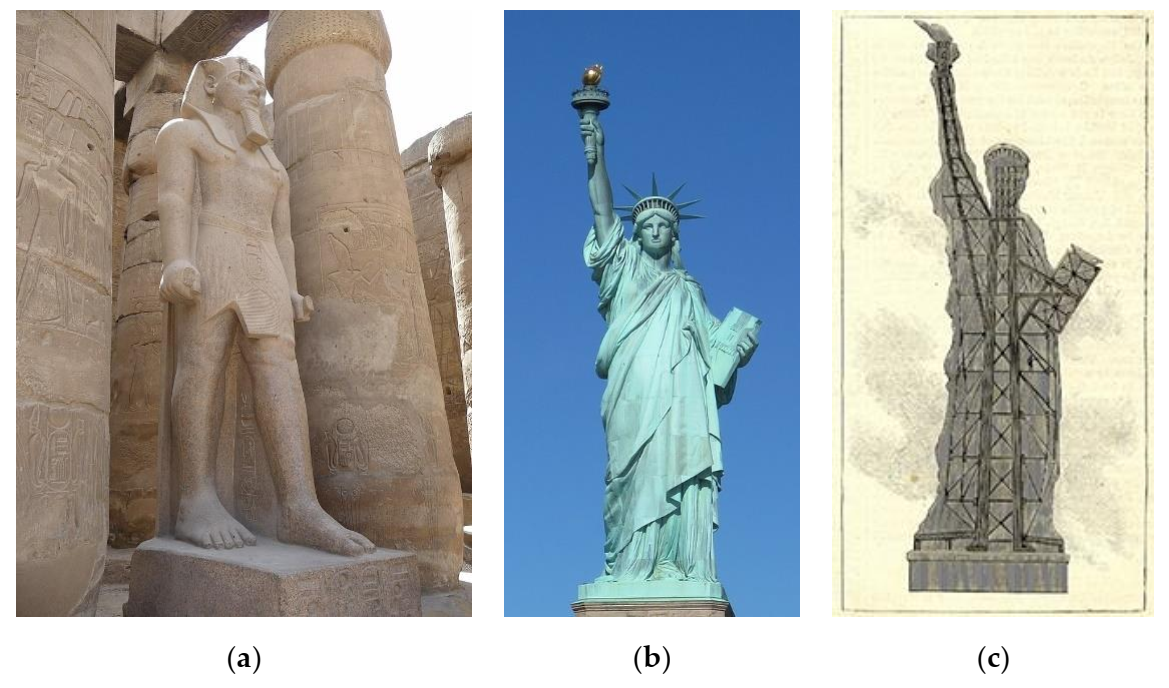




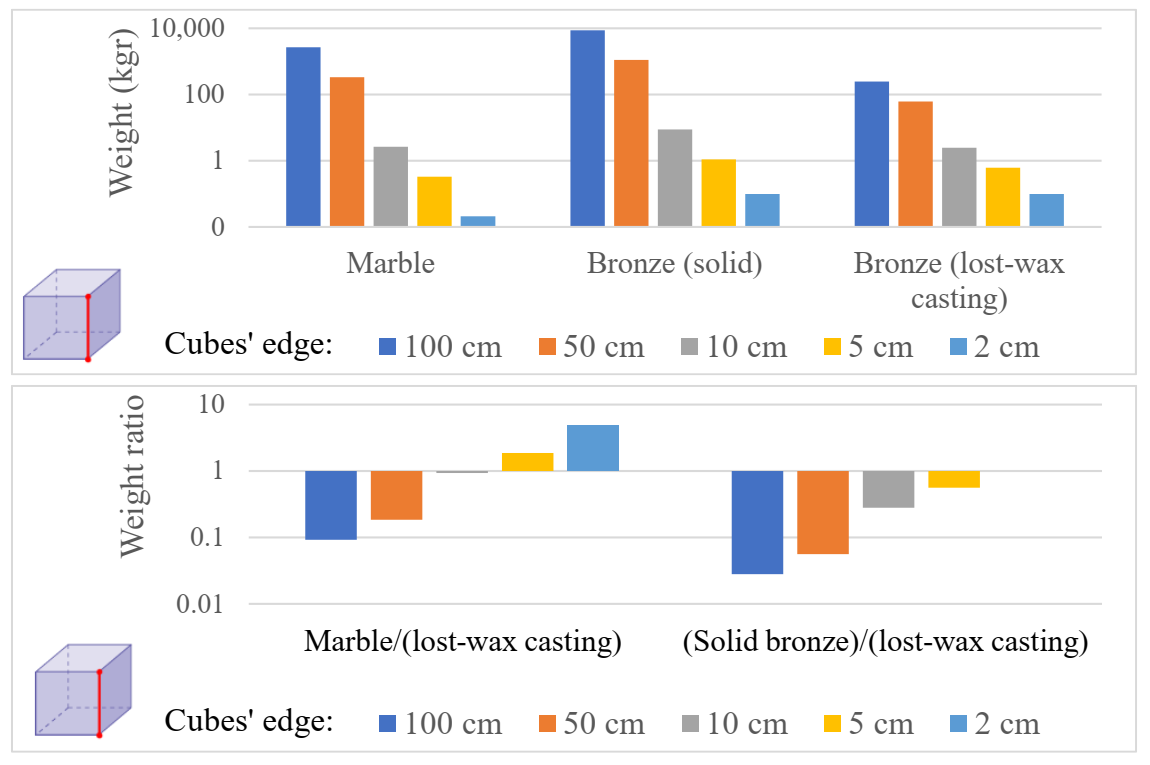
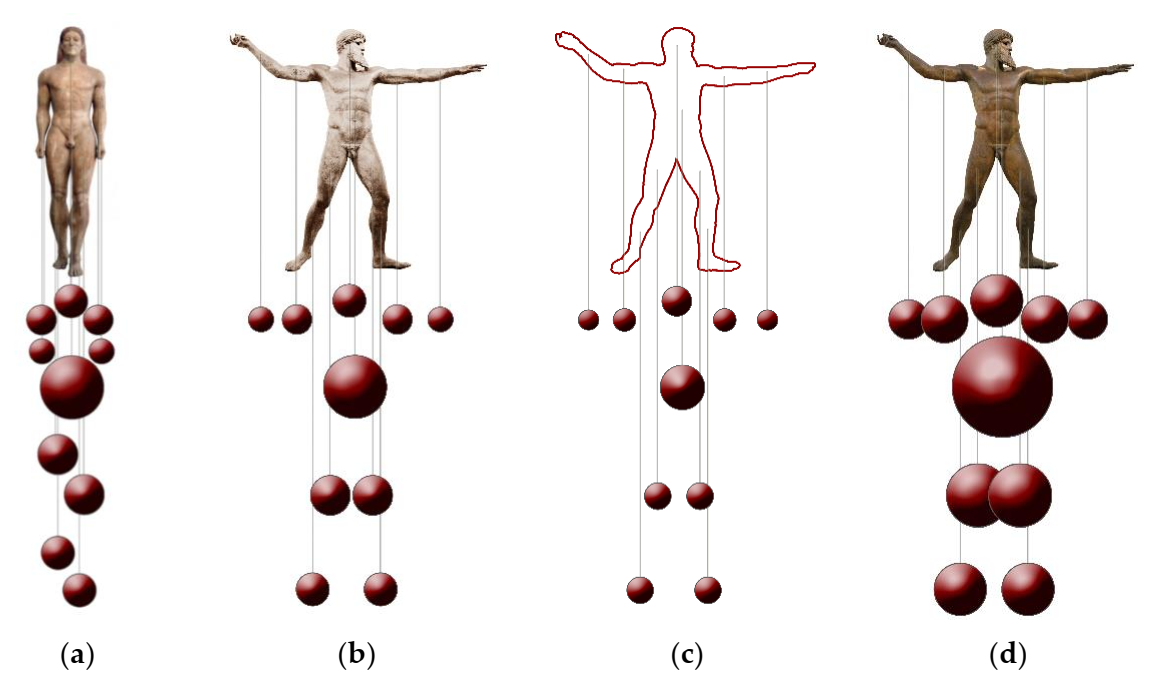
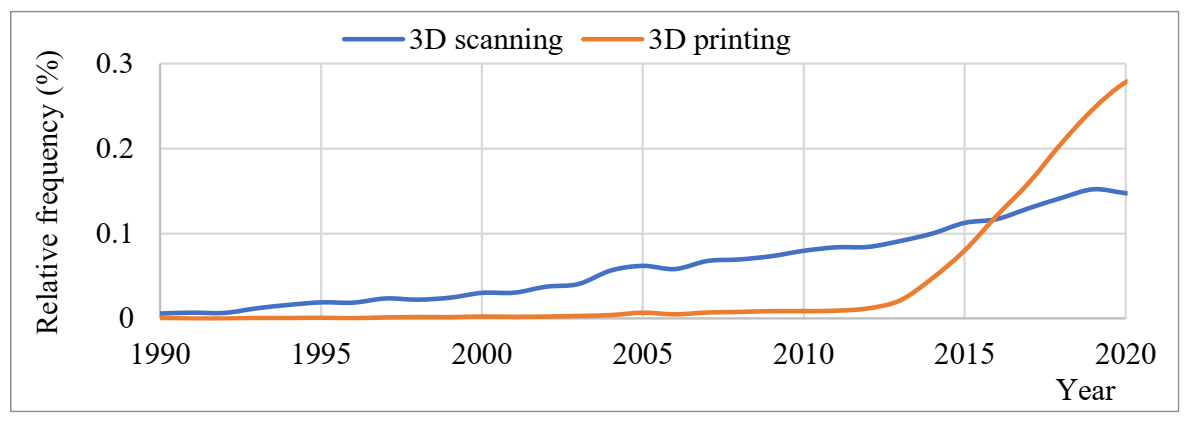

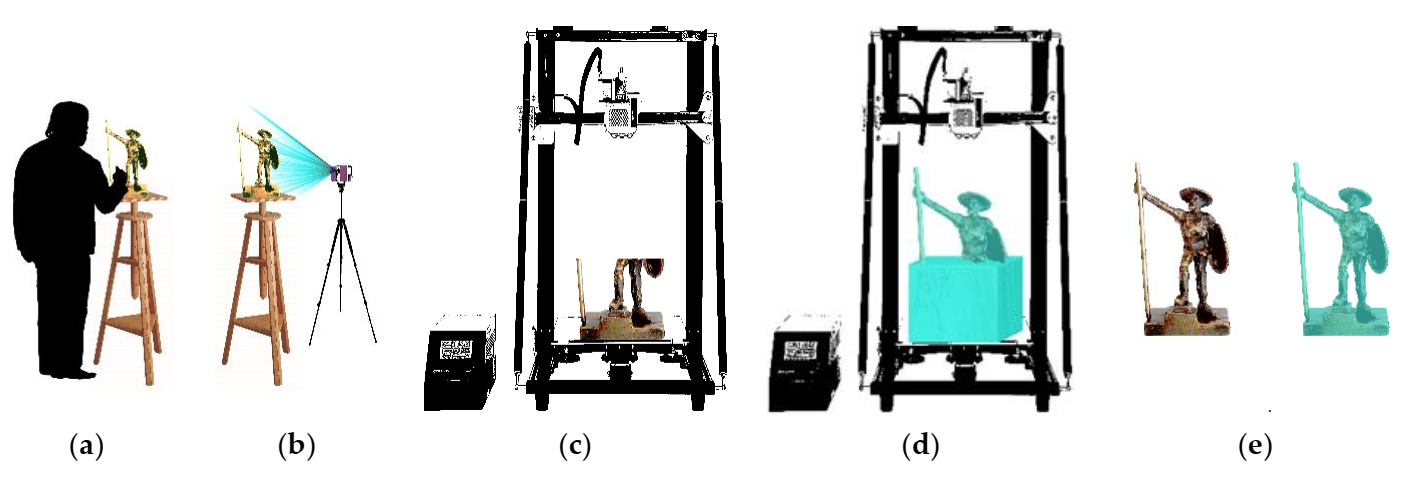



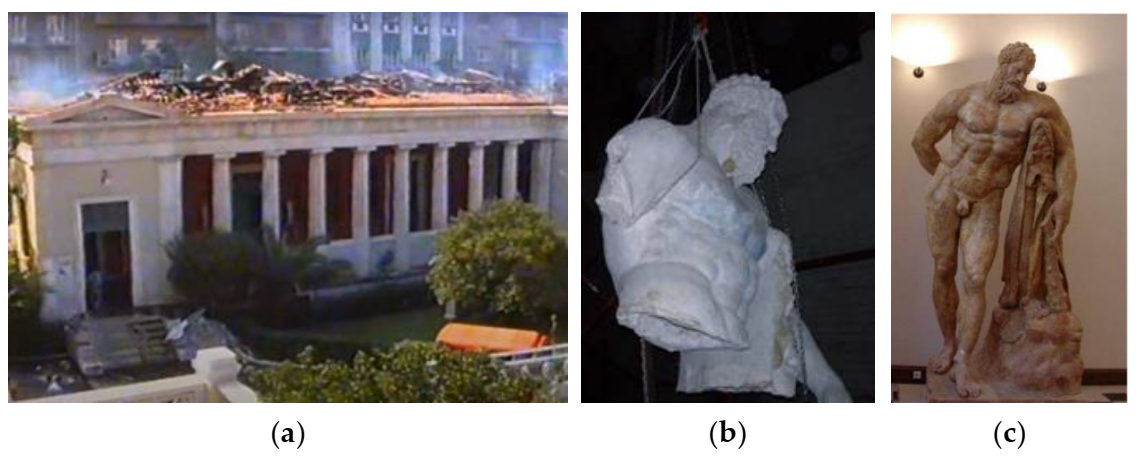

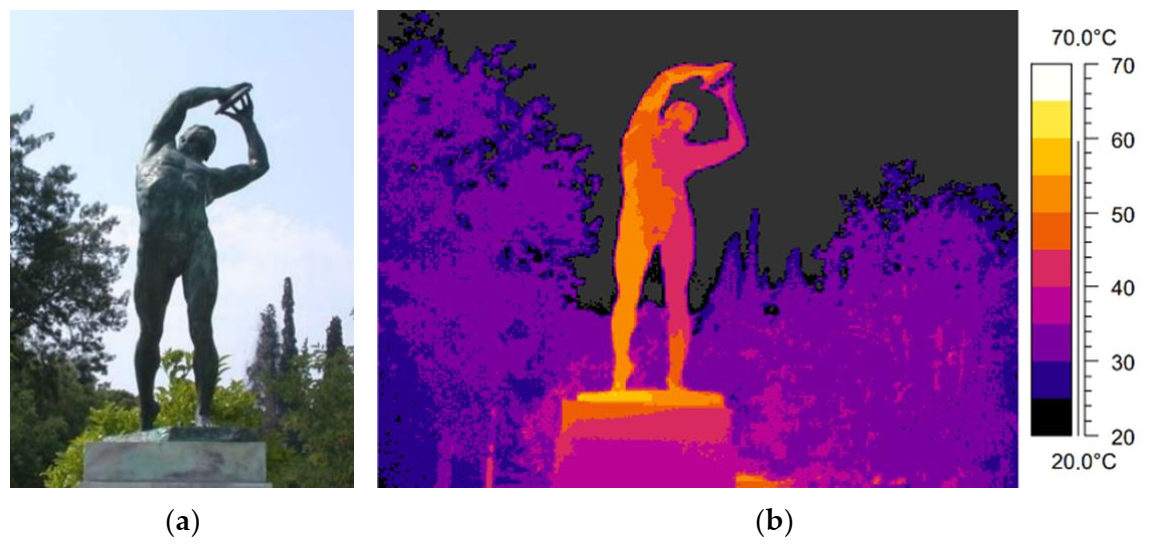
| Photogrammetry | Structured Light | Laser Scanning | Computerized Tomography | |
|---|---|---|---|---|
| Equipment | Software; powerful processing | Specialized equipment | Specialized equipment | Highly specialized equipment |
| Users’ training | Advanced | Typical | Typical | Highly professional |
| Indoors/outdoors | Indoors and outdoors | Only indoors | Indoors, errors in bright environment | Only inside the scanner |
| Large objects | Yes | No | Yes | No |
| Texture | Good depiction | Good depiction | Errors in metal textures | Excellent depiction |
| Precision | Needs specialized calibration for high precision | High | High | Excellent |
| Easy to get results | No | No | Yes | Yes |
| Cost | Low | Medium | Medium | Very high |
| Synthetic Material | Metals | |||||||||
|---|---|---|---|---|---|---|---|---|---|---|
| SLA | SLS | FDM | DLP | MJF | PJ | DMLS | EBM | WAAM | CNCR | |
| Details | Excellent | Good | Average | Average | Excellent | Excellent | Excellent | Good | Good | Good |
| Colours | Limited | Multi | Multi | Limited | Multi | Multi | Metal | Metal | Metal | Material |
| Texture | Average | Excellent | Average | Rough | Rough | Excellent | Excellent | Good | Good | Rough |
| Durability | High | Good | Average | Good | High | High | Excellent | Excellent | Excellent | Excellent |
Publisher’s Note: MDPI stays neutral with regard to jurisdictional claims in published maps and institutional affiliations. |
© 2022 by the authors. Licensee MDPI, Basel, Switzerland. This article is an open access article distributed under the terms and conditions of the Creative Commons Attribution (CC BY) license (https://creativecommons.org/licenses/by/4.0/).
Share and Cite
Sargentis, G.-F.; Frangedaki, E.; Chiotinis, M.; Koutsoyiannis, D.; Camarinopoulos, S.; Camarinopoulos, A.; Lagaros, N.D. 3D Scanning/Printing: A Technological Stride in Sculpture. Technologies 2022, 10, 9. https://doi.org/10.3390/technologies10010009
Sargentis G-F, Frangedaki E, Chiotinis M, Koutsoyiannis D, Camarinopoulos S, Camarinopoulos A, Lagaros ND. 3D Scanning/Printing: A Technological Stride in Sculpture. Technologies. 2022; 10(1):9. https://doi.org/10.3390/technologies10010009
Chicago/Turabian StyleSargentis, G.-Fivos, Evangelia Frangedaki, Michalis Chiotinis, Demetris Koutsoyiannis, Stephanos Camarinopoulos, Alexios Camarinopoulos, and Nikos D. Lagaros. 2022. "3D Scanning/Printing: A Technological Stride in Sculpture" Technologies 10, no. 1: 9. https://doi.org/10.3390/technologies10010009
APA StyleSargentis, G.-F., Frangedaki, E., Chiotinis, M., Koutsoyiannis, D., Camarinopoulos, S., Camarinopoulos, A., & Lagaros, N. D. (2022). 3D Scanning/Printing: A Technological Stride in Sculpture. Technologies, 10(1), 9. https://doi.org/10.3390/technologies10010009









